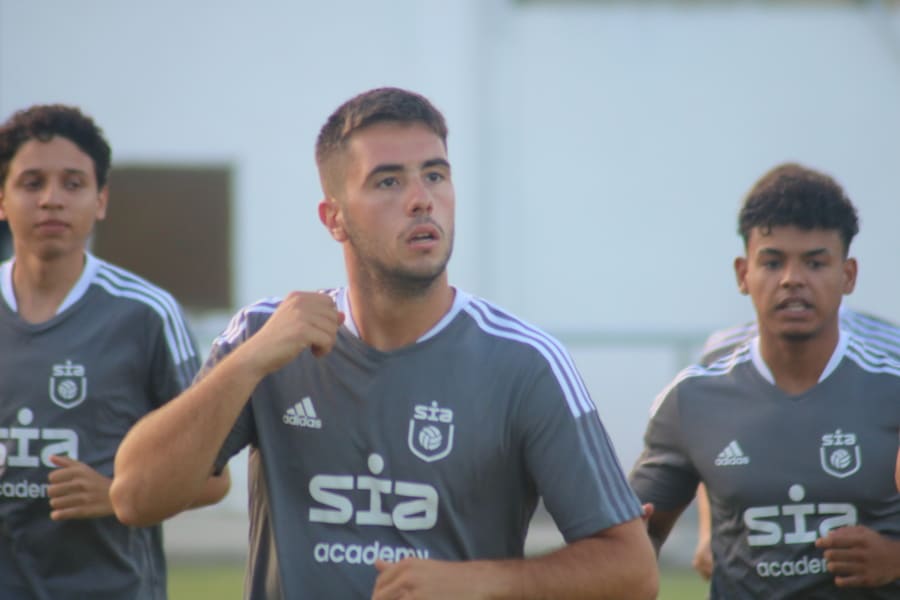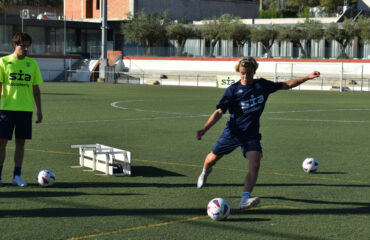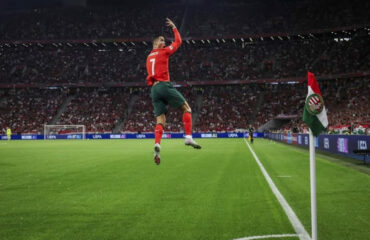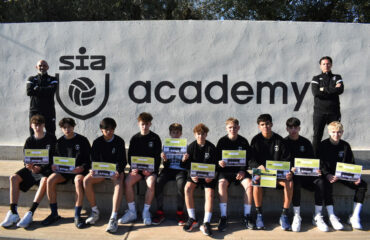Football requires a combination of physical and technical skills. To improve performance on the field, footballers must incorporate specific exercises into their training routine. At SIA Academy we teach you the 15 best exercises focused on developing strength, agility, explosiveness and ball control . These exercises are essential to optimize performance and prevent injuries.
Table of contents
Strength and endurance training
Strength and endurance training is essential for footballers, as it helps improve physical capacity and performance on the field. Working on these aspects allows for increased muscle power, improved speed and prevent injuries.
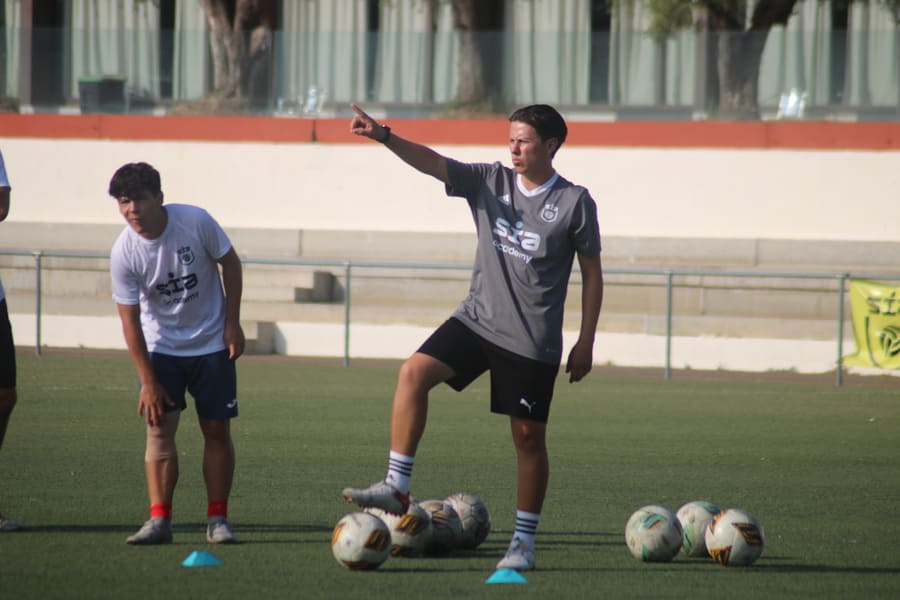
Importance for footballers
Strength and endurance are key factors in football. Greater strength levels translate into better performance in contact situations and more effective body control during play. Good endurance allows you to maintain performance throughout the match, avoiding fatigue at crucial moments.
How to improve lower body strength
Strengthening the lower body is essential for footballers. This muscle group includes the quadriceps, hamstrings, glutes and calves. A strong lower body not only improves performance, but also reduces the risk of injuries common in this sport.
Barbell squats
Barbell squats are one of the most complete exercises for developing strength in the lower body. This movement isolates and intensely works the leg muscles, helping to increase power and endurance.
- Correct alignment of the feet at shoulder height.
- Placing the bar on the upper back.
- Maintaining an upright posture during movement.
- Controlled descent until forming a 90 degree angle at the knees.
- Exhale as you return to the starting position, squeezing your glutes at the end.
Hex Bar Deadlift
The hex bar deadlift is another key exercise that combines features of both the traditional deadlift and squat. This exercise promotes the development of strength and explosiveness, benefiting footballers in their overall performance.
- Position your feet shoulder-width apart in the center of the hex bar.
- Hold the bar with a firm grip.
- With your back straight and looking straight ahead, apply force toward the ground to lift the bar.
- This exercise not only strengthens the quads, but also works the glutes and hamstrings.
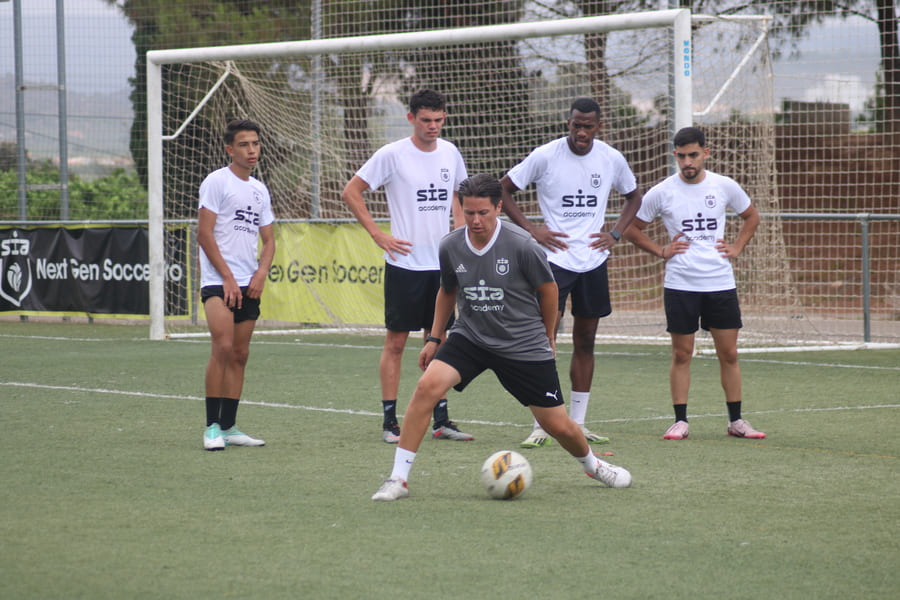
Agility and coordination exercises
Agility and coordination are fundamental skills for footballers, as they allow for a better response in game situations. These exercises are designed to improve reaction speed, body control and the ability to perform quick and precise movements.
Methods to improve agility
There are a number of methods that can be implemented to increase agility on the field. It is crucial to incorporate specific exercises that challenge mobility and force the player to quickly adapt to new positions. Below are some effective strategies:
- Cone training to practice changes of direction.
- Straight line and zigzag speed exercises.
- Using agility ladders to improve foot quickness.
- Practice reacting to visual or auditory stimuli.
Avoiding cones in slalom
The slalom cone dodging drill is ideal for working on lateral agility and improving coordination. This drill simulates situations that footballers face during a match, where they must change direction quickly.
Specific exercise with ball
To maximize the effectiveness of the exercise, it can be performed with a ball. This not only improves agility, but also develops ball control while performing quick movements. To perform this exercise, the following steps should be followed:
- Place a series of cones in a straight line, leaving approximately one metre between each one.
- Dribble the ball while passing between the cones, alternating the leg with which you touch the ball.
- Try to maintain a constant speed and not knock down the cones.
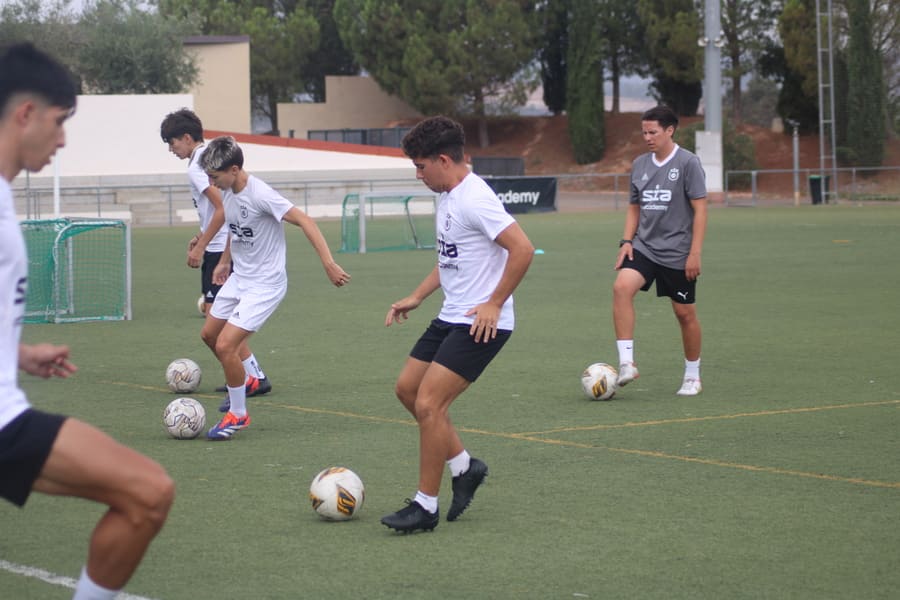
Improving in-game control
Practicing dribbling around cones also helps to reinforce control and dribbling technique. Once this exercise has been mastered, defenders or one-on-one practice can be incorporated, adding a pressure and competition component.
Importance of the agility ladder
The agility ladder is another essential resource in the training of football players. This equipment allows for various exercises that improve foot speed and general coordination.
- Ladder exercises not only increase speed, but also strengthen the muscles of the legs and core.
- Different movement patterns can be performed, including side steps, jumps and changes of direction.
- With the ladder, concentration is encouraged, which is vital during the game to make quick decisions.
Incorporating the agility ladder into training routines helps footballers achieve optimal performance, promoting effective execution of critical skills on the field.
Increased explosiveness
Explosiveness is a fundamental quality for footballers, as it allows them to make quick and powerful movements on the field. Integrating specific exercises that develop this ability can make a difference in sports performance.
Plyometric jumps
Plyometric jumps are a type of training that focuses on improving a player’s explosiveness. This exercise trains the muscles to generate maximum force quickly from a static position. It is essential in the training of a footballer, as it allows for improvement in jumping ability, speed and reaction.
To perform plyometric jumps, you can start with basic exercises such as depth jumps from a platform and controlled landings. Over time, you can increase the height of the platform and the angles of the jump to increase the difficulty.
Unilateral explosive jump
The unilateral explosive jump is an exercise that focuses on improving the power and explosiveness of each leg individually. This type of exercise is especially useful in soccer, where players often need to change direction quickly and have dynamic support on one leg. Performing this exercise helps to balance the strength and power in both limbs, which is key to preventing injuries.
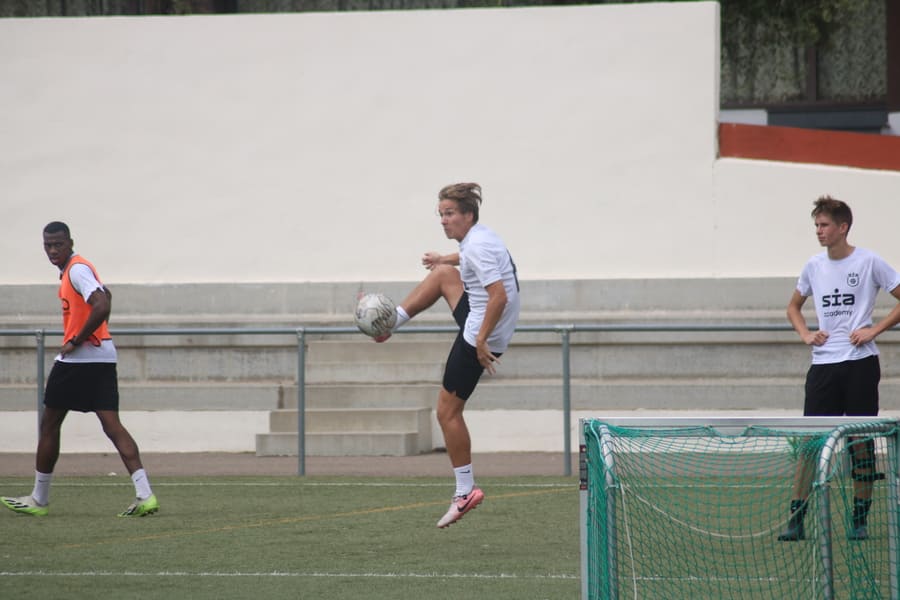
Benefits for high performance
Incorporating unilateral explosive jumps into your training routine can bring multiple benefits, such as:
- Significant increase in power in the dominant and non-dominant leg.
- Improves the ability to perform faster and more effective movements during the game.
- Improving stability and body control, essential when making turns or changing direction.
Preventing lower body injuries
In addition to their performance benefits, unilateral explosive jumps help establish a solid foundation that can contribute to injury prevention. This is because they strengthen stabilizing muscles and help improve balance. Some important aspects in this regard include:
- Strengthening the ligaments and tendons around the joints.
- Promoting proper movement patterns, reducing the risk of overuse injuries.
- Increased body awareness, promoting a better reaction to unexpected game situations.
Speed development
Developing speed is crucial in football, as it allows players to move quickly and effectively on the field. Good speed training can make all the difference in crucial game situations.
Static sprint with resistance band
The static band sprint is a fundamental exercise that helps improve acceleration and explosiveness. This exercise involves the use of a resistance band, which provides an additional load during the sprint, contributing to greater muscle development in the legs.
To perform the static sprint, this process must be followed:
- Attach a resistance band to a fixed point, making sure it is secure.
- Place the band around your waist and move away until you feel adequate resistance.
- From a stable position, perform 10 to 15 meter sprints, making sure to maintain good technique throughout each run.
This exercise not only increases speed, but also improves explosive strength in the leg muscles, which is essential for any footballer who wants to increase their performance on the field.
Techniques to improve speed on the field
Improving speed on the field requires the implementation of various strategies and drills that emphasize acceleration, endurance, and running technique. Some effective techniques are detailed below:
- Starting Drills: Performing sprints from a static or squatting position helps players improve their reaction times and initial speed.
- High Intensity Intervals: Performing short, fast runs followed by rest periods allows the player to maximize their anaerobic capacity.
- Use hills: Running on hills provides natural resistance that strengthens your legs and improves your running technique.
- Training changes of pace: Including exercises that require changes of speed and direction are essential to simulate game situations, where footballers must adapt quickly.
Implementing these techniques into the training routine helps footballers achieve comprehensive development in speed, which is vital for competitive performance in football.
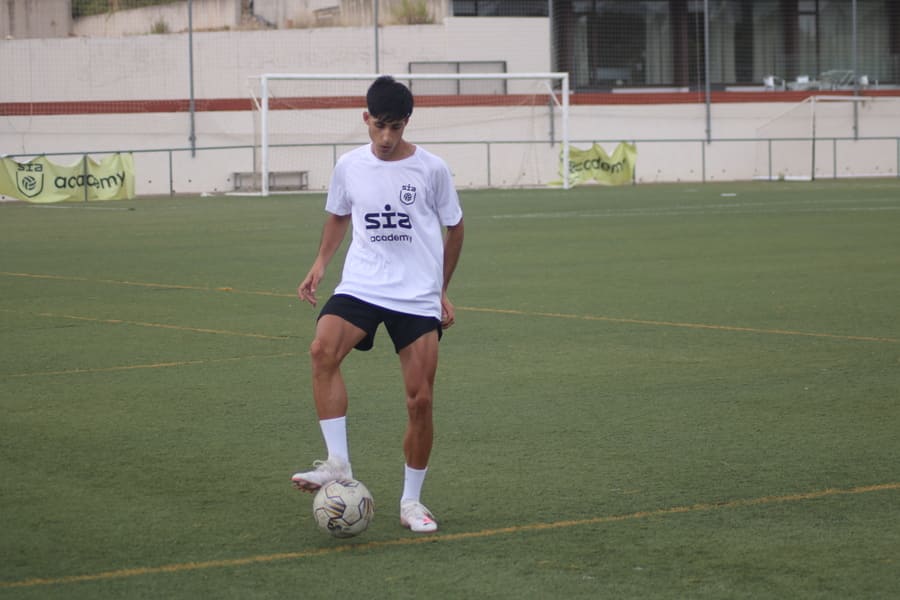
Improved ball control
Ball control is essential in football, as it allows for precise and effective movements. Good ball control technique helps to execute plays and the ability to react on the field.
Quick control exercise
This drill focuses on improving ball control skills at speed. Cones and a ball are required to simulate game situations. The drill consists of:
- Place several cones in a straight line, separated by approximately one meter.
- The player must dribble the ball between the cones as quickly as possible, making sure not to knock any of them down.
- It is essential to keep the ball close and use both the right and left foot, alternating their use.
By increasing the speed and tempo of the drill, agility and precision in control are improved. This drill is essential for developing the dexterity needed in real game situations.
How to carry the ball efficiently
Carrying the ball efficiently involves maintaining proper control, speed and direction. Some useful tips are:
- Keep your head up to observe the field and make quick decisions.
- Use both parts of the foot to facilitate turns and changes of direction.
- Develop the use of the inside and outside of the foot to vary the touch and trajectory.
- Practice changes of pace that allow you to overcome your opponents.
Over time, practicing these techniques will allow footballers to carry the ball more effectively, optimizing their performance in the game.
Best practices for mastering the pass
Passing is one of the key skills in football. To master it, the following practices must be taken into account:
- Make precise passes using the inside of your foot for greater control and accurate targeting.
- Exercise the strength of the pass, which must be in accordance with the distance you intend to reach.
- Incorporate the practice of passing on the move, achieving fluid communication with teammates.
- Use different passing techniques, such as through ball and lateral pass, depending on the game situation.
Continuous and conscious practice of these skills is crucial to improving team play and increasing effectiveness in matches.
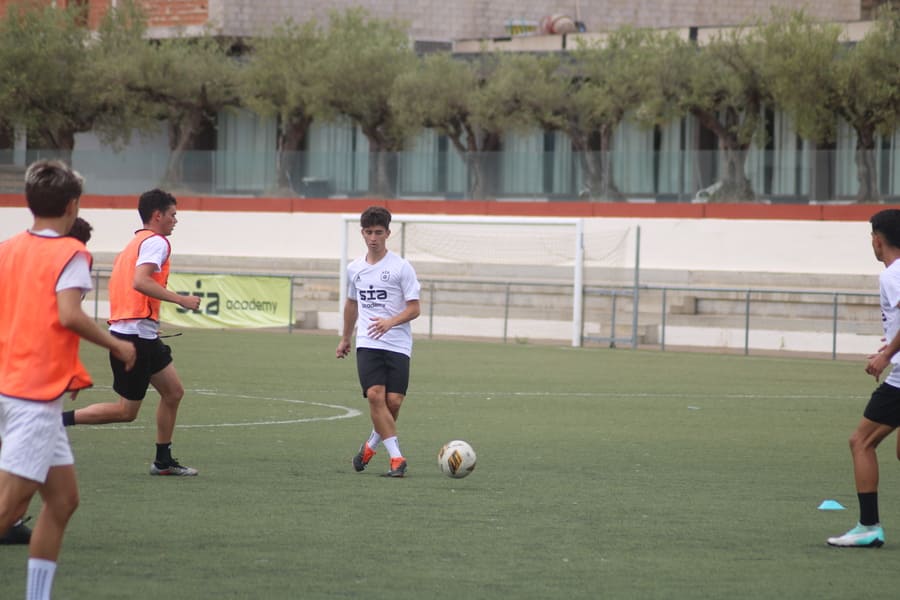
Individual solo exercises
Solo exercises are essential for footballers to improve their technique, strength and ball control. This practice allows them to work without the need for a partner, focusing on strengthening individual skills. Below we describe their importance and a specific exercise.
Importance of individual training
Individual training is essential in the development of a footballer. Through solo practice, players can:
- Focus on specific technical skills, such as ball control and dribbling.
- Improve confidence in handling the ball without pressure from an opponent.
- Develop physical endurance and muscle strength through exercises designed for personal work.
- Identify areas for improvement and set clear goals that can be achieved individually.
- Optimize training time, since they do not depend on the availability of other players.
One-Leg Side Jumps
This exercise is crucial for developing power and agility in lateral movements, which are essential in football. One-legged lateral jumps not only strengthen the legs, but also improve coordination and balance.
How to do it:
To perform one-legged lateral jumps, the following procedure must be followed:
- Place a resistance band around your ankles to increase the difficulty.
- Stand on one leg, with the other slightly raised and ready to jump.
- Perform a lateral jump to one side, landing softly on the same leg that remains on the ground.
- Always maintain tension on the resistance band during exercise.
- Repeat the movement to the opposite side, alternating legs after a set number of repetitions.
Benefits:
The benefits of performing one-legged lateral jumps cover several areas:
- Improves leg strength and agility, essential for quick movements on the field.
- Increases stability, which is vital to preventing injuries during matches.
- Develops reaction capacity, which is crucial in situations where direction changes during the game.
By incorporating individual exercises, such as single-leg side jumps, footballers can effectively work on their performance, optimising every aspect of their fitness and technical ability.
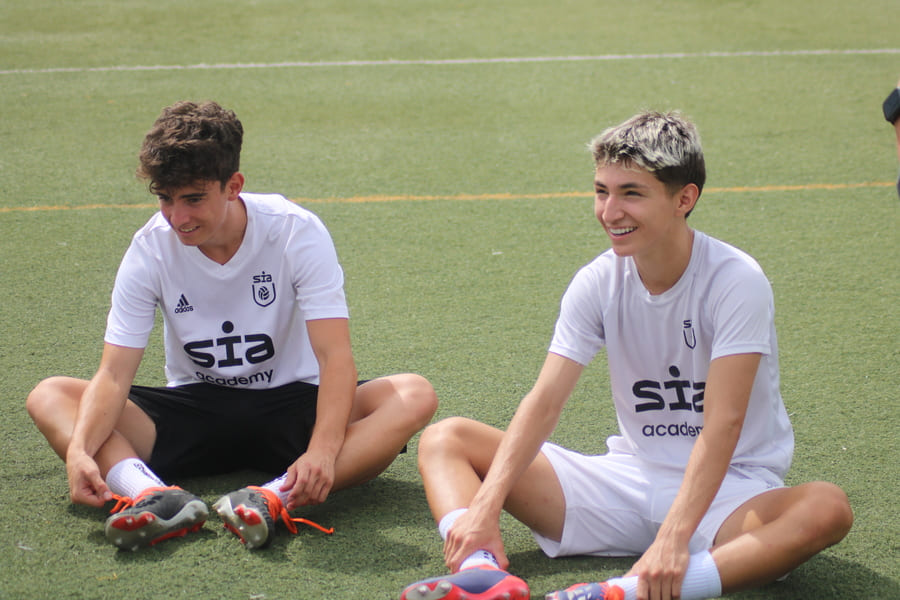
Teamwork
Teamwork is essential in football, as cooperation between players can make all the difference in the team’s overall performance. Performing drills that encourage communication and synchronization between players is key to success on the field.
Passing drills on the move
Passing mastery is essential to maintaining control of the game. Moving passing drills allow footballers to practice the accuracy and speed needed to make effective passes during a match. This type of training helps improve the flow of the game and establish a better connection between players.
Short passes and long passes
- Short passes are essential to maintaining possession of the ball in pressing situations. Players must work on accurate passes that are made in a confined space.
- Long passes allow players to advance quickly up the field and create scoring opportunities. They require proper technique and good communication between players to ensure the ball reaches its intended destination.
Effective communication in the game
Communication on the field is vital to coordinate movements and tactics. Players must develop verbal and non-verbal skills to make themselves understood during the game. Drills that involve passing the ball under different circumstances help to improve this communication.
It is important to practice game situations where players must shout, point or use gestures to indicate their intentions. This not only improves interaction, but also strengthens team cohesion.
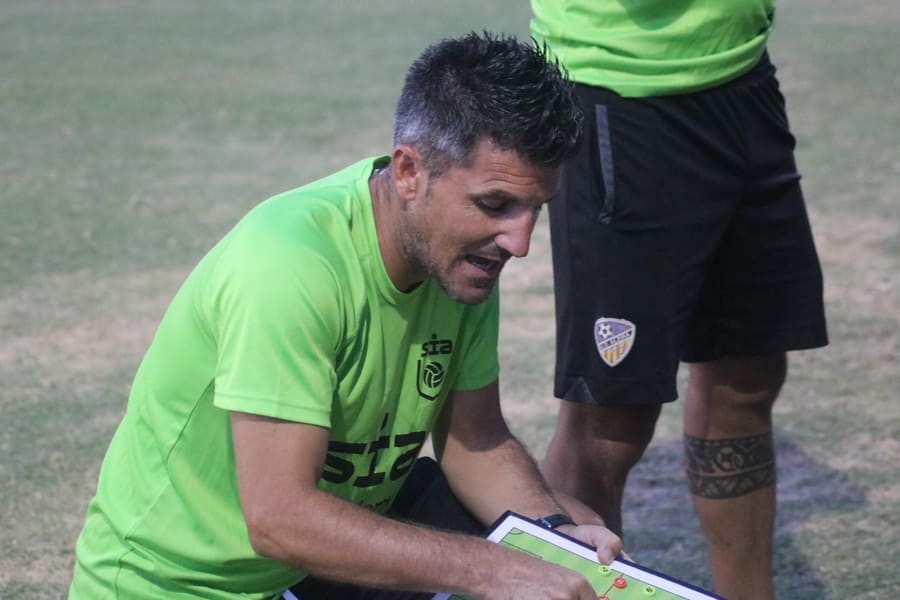
Defense and attack strategies
Defending and attacking strategies are fundamental in soccer. These tactics determine how a team organizes itself to protect its goal and how it sets out to score goals. Below are specific drills and techniques that help develop these skills.
Cone toss exercise (1 vs 1)
The cone toss drill is ideal for practicing one-on-one situations, where one player attempts to dribble and the other must defend effectively. This drill not only improves individual skills, but also teaches players to read the game and anticipate the opponent’s moves.
How to perform the exercise:
- Place a series of cones in a line or zigzag to define a course.
- One player positions himself with the ball, while the other positions himself as a defender.
- The player with the ball must try to avoid the cones by dribbling and changing direction.
- The defender must try to close the space, anticipating the attacker’s movements.
- Conditions can be set, such as limiting the number of taps or time, to increase the difficulty.
This drill promotes agility, reaction speed and the ability to make quick decisions on the pitch. Players learn to apply dribbling techniques and active defence, strengthening their confidence in pressure situations.
Dribbling techniques in dynamic situations
Dynamic situations in a football match require players to be able to dribble efficiently while moving. These techniques are essential for getting past opponents and creating goal-scoring opportunities.
Recommended exercises:
- High-speed dribbling: Practice dribbling along a straight line while accelerating. This helps develop ball control and coordination as speed increases.
- Using feints: Include feints and tricky moves in your dribble. Study moves like the step-over and the wheel to confuse the defender.
- Pressure dribbling: Involve a defender who acts to put pressure on the player dribbling. This simulates real game conditions and teaches how to handle pressure.
Constant work on these dribbling techniques allows the player to improve his ability to create space and break through defensive lines. Regular practice encourages creativity and flexibility in the game, making footballers much more effective in attacking situations.
Finishing techniques
Finishing techniques are essential for any footballer who wants to convert chances into goals. Working on the accuracy and power of your shots allows you to maximise your potential in critical game situations.
Kicking exercises
Shooting drills are essential to improving a player’s ability to finish a play. Practicing different types of shots helps to hone technique and increase confidence in front of goal.
Shots from different positions
Practicing shooting from various positions on the field allows players to adapt to a variety of situations. This includes shots from outside the box, inside the box and tight angles. Varying technique in each position helps develop greater versatility in attack.
- Shots from outside the box: Focus on power and accuracy. It is important to maintain a good posture and find the right angle for an effective shot.
- Shots inside the box: These shots usually require speed and precision. Players must learn to use both the inside and the instep of their foot to score.
- Shooting from tight angles: Practicing shooting in tight spaces is crucial, as players often find themselves in these scenarios during the game.
Improving technique under pressure
The ability to finish under pressure is crucial. Players should train in situations that simulate moments of intense play, such as when facing defenders or the goalkeeper. This can be done through specific drills that involve defenders or time constraints.
- Finishing drills in 1v1 situations, where the player must shoot before the defender reaches him.
- Timed shots, where players must finish quickly upon receiving the ball, simulating the pressure in a real match.
- Variation of shooting techniques under pressure, training different types of shots such as the volley, the header, or the shot on the run.
Preparing for critical situations
Preparing for critical situations in football is essential for players to manage pressure and make effective decisions in decisive moments. This section covers drills and strategies that help footballers hone their technique and stay calm under pressure.
Penalty kick drill
The penalty kick is one of the most critical situations in a football match, where a mistake can change the course of the match. Preparation for this instance focuses on repetition and proper technique. It is important to create a controlled environment that simulates the pressure of a real match.
To practice, you can follow these steps:
- Place a ball on the penalty spot.
- Define the goal area and select a target location to shoot.
- Practice repeatedly, focusing on striking technique.
- Simulate the pressure of a match by involving other players, either as opponents or as part of the public.
This drill should be performed regularly so that players become familiar with the situation and can improve their concentration and accuracy in high-pressure moments.
Managing pressure and tension
The ability to manage pressure is essential in football, as players are often faced with situations that require optimal performance under high stress. To help footballers deal with these situations, it is vital to work on mentality and relaxation techniques.
Some management strategies include:
- Controlled breathing: Practice breathing techniques that help reduce anxiety and improve concentration during the game.
- Visualization: Imagining game situations, such as taking a penalty shot, to create a positive mental experience and build confidence.
- Pre-match routines: Establish a series of actions that are carried out regularly before matches to create an atmosphere of familiarity and reduce pressure.
- High-pressure training: Simulate matches and critical situations in training, where players must perform under conditions that mimic the pressure of a real match.
These tactics not only improve the ability to cope with stress, but also optimize athletic performance at the most crucial moments of a match.
Core development and stability
Core development and stability are key to football training. A strong core provides a solid foundation for the execution of technical movements, improves balance and reduces the risk of injury. Key exercises and their benefits are detailed below.
Push-up + climber combination
Combining push-ups with mountain climbers is a comprehensive exercise that works both the upper and lower body, as well as strengthening the core. This exercise not only builds muscle, but also promotes endurance and coordination. Execution requires concentration and proper technique.
- How to do it:
- Start in a plank position, with your arms extended and your body in a straight line.
- Perform a push-up, lowering your body towards the floor.
- When returning to the starting position, alternate bringing your knees towards your chest, as if you were running in place.
- Benefits:
- Strengthens the muscles of the abdomen, chest and arms.
- Improves cardiovascular endurance.
- Develops stability and body control during dynamic movements of the game.
Improving body stability
Core stability is crucial in football, as it optimises technical and tactical performance. Core exercises help prevent injuries by strengthening the muscles that stabilise the pelvis and spine. These exercises are essential for achieving good balance on the playing field.
- Recommended exercises:
- Front and side plank: These exercises are effective for working the core isometrically, maintaining positions that activate the entire abdominal region.
- Swiss ball exercises to perform twists and turns, strengthening the oblique muscles.
- Balancing on one leg, which mimics the demands made on movements on the field.
- Benefits of maintaining good stability:
- Increases efficiency in the execution of technical movements.
- Reduces the risk of injury by providing adequate support to the joints.
- Facilitates quick changes of direction, a crucial skill during a match.
Injury prevention and recovery
Injury prevention and recovery are fundamental aspects of a footballer’s career. Implementing proper techniques and following a warm-up and cool-down protocol can significantly reduce the risk of injury and facilitate a more efficient recovery.
Specific techniques for footballers
There are several techniques that footballers can incorporate into their routine to prevent injuries and facilitate recovery. Some of the most effective include:
- Flexibility training: Performing stretching exercises before and after each training session can increase muscle elasticity and prevent muscle strains.
- Muscle strengthening: Including strength exercises, particularly for the lower body, helps improve the stability and resistance of the joints most prone to injury.
- Proprioception exercises: These activities improve balance and coordination, crucial for optimal performance on the field and to avoid injuries.
- Massages and physiotherapy treatments: These therapies can relieve muscle tension and help in recovery after intense physical effort.
- Use of bandages or supports: In some cases, the use of elastic bandages or orthoses can offer additional support to the joints during play.
Importance of warming up and cooling down
Warming up and cooling down are essential stages in any footballer’s training. Warming up prepares the muscles and cardiovascular system for physical activity, while cooling down helps to minimise the risk of injury at the end of the session.
The warm-up should include:
- Gentle aerobic exercise: Activities such as jogging or jumping rope for 5 to 10 minutes.
- Dynamic Stretches: Include movements that promote joint mobility and muscle activation, such as arm circles or walking lunges.
- Sport-Specific Activities: Dribbling the ball or making soft passes helps prepare the specific muscles used in the game.
Cooling down is equally vital and should consist of:
- Low intensity exercises: Gradually reduce the intensity with light jogging or walking.
- Static Stretching: Focus on the muscles worked to improve flexibility and speed up muscle recovery.
- Hydration and nutrition: Replenishing fluids and nutrients lost during the session is key to proper recovery.
Personalized training program
A personalised training programme is essential to optimise the performance of each footballer. This approach allows exercises to be tailored to individual capabilities and needs, thus promoting more effective development and reducing the risk of injury.
Adaptation of exercises to each level
Footballers vary in their skill level, fitness and experience. Therefore, it is essential to adapt exercises to each of these factors to ensure optimal progress. To do this, the following aspects can be considered:
- Skill Level: Players can be beginners, intermediate, or advanced. Drills should be scalable, starting with simpler versions and increasing in difficulty as you improve.
- Physical Condition: Assessing each player’s endurance, strength and agility will allow the most appropriate exercises to be selected. Physical tests can be implemented before designing a specific program.
- Personal goals: Each player may have different goals, such as improving speed, passing technique or finishing. Drills should align with these goals, helping each player to achieve their goals effectively.
Tracking progress and adjusting routines
Progress monitoring is key to determining the effectiveness of the program. It allows for identifying areas of improvement as well as the impact of the exercises on the player’s overall performance. Some strategies for monitoring include:
- Periodic assessments: Conduct tests every 4 to 6 weeks to measure progress in strength, agility and endurance. This allows routines to be adjusted and progress to be monitored accurately.
- Session log: Keep a training diary that includes details about the exercises performed, their intensity and duration. This log is useful for both the player and the coach.
- Continuous feedback: Establish fluid communication between the player and the coach. Feedback on performance in training and matches helps to make necessary adjustments to the program.
Personalization and proper monitoring not only optimize performance, but also foster motivation by seeing tangible results. With a continually reviewed and adjusted program, footballers can be at their best on the field.



